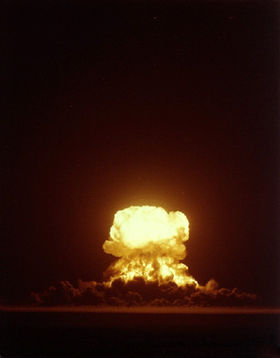Upshot-Knothole Harry
| Upshot–Knothole Harry | |
|---|---|
 | |
| Information | |
| Country | United States |
| Test series | Operation Upshot–Knothole |
| Test site | Nevada Test Site |
| Date | May 19, 1953 |
| Test type | Atmospheric (tower) |
| Yield | 32 kt |
| Test chronology | |
Upshot–Knothole Harry (UK#9) was a
Device
The test device, codenamed Hamlet, was detonated atop a 300-foot (91 m) tower,[5] the device produced a yield of 32 kilotonnes.[6] The device had a diameter of 56 inches (1,400 mm) and a length of 66 inches (1,700 mm). Its weight was 4 short tons (3.6 t).[3]
The device was designed by Ted Taylor at the Los Alamos National Laboratory of the United States of America, and is distinguished from all others because it was the most efficient pure fission design with a yield below 100 kt ever tested.[5] The design utilized a new hollow core concept.[7] The concept was termed as "radical implosion system" aiming towards reducing the amount of fissionable materials present in the weapon's core while generating moderately high yield.[8]: 201
Detonation

The device was detonated in Area 3 of the test site.[1]
Deposition
Of the 11 Upshot–Knothole tests, the so-called Harry test deposited the 3rd highest amount of Caesium-137, Niobium-95, Strontium-90, Zirconium-95, the fourth highest deposit for Niobium-95m, Praseodymium-144, fifth for Uranium-240, Ruthenium-106, sixth for Iodine-131, Tellurium-127m, eighth for deposition of Cobalt-60, tenth for deposition of Europium-155, thirteenth for Strontium-89, Yttrium-90, and sixteenth for Beryllium-7, (the source lists Sr-90 twice, at 3rd and thirteenth, thirteenth was omitted here).[3] The deposition pattern was most similar to test name CLIMAX.[3]
Monitoring personnel including
Hicks (1981) evaluated the gamma-exposure rates and levels of radionuclides. Within the report by Hicks he was required to omit data of U-233, U-235, U-238 & Pu-239, and Pu-240 in order to make the report unclassified.[10][11]
In measurement of cumulative exposures rates of populations within a 300-mile radius of the test site, of the period 1951 to 1959, the Upshot–Knothole tests was found to have produced 50% (rounded figure) of exposure rate within the population. Of the 50%, 75% (rounded figure) was due to the test-shot Harry.[12]
See also
References
- ^ a b Shots ENCORE to CLIMAX: the final four tests of the UPSHOT-KNOTHOLE series, 8 May - 4 June 1953. published by United States. Defense Nuclear Agency, JRB Associates 1982, 230 pages. 1982. Retrieved 2015-11-28.
- ^ U.S. Department of Energy / Nevada Operations Office, United States Nuclear Tests - July 1945 through September 1992, December 2000, DOE/NV-209 Rev 15 Archived 2006-10-12 at the Wayback Machine
- ^ ISBN 978-1881043133. Retrieved 2015-11-28.
- ^ "Los Alamos National Lab: National Security Science".
- ^ a b "Operation Upshot-Knothole". The Nuclear Weapon Archive. 2002-06-19. Retrieved 2017-12-30.
- ^ a b Comprehensive Nuclear-Test-Ban Treaty Organization (& United States military). article. published by Comprehensive Nuclear-Test-Ban Treaty Organization . Retrieved 2015-11-28.
- ^ Newsletter published and written by the (United States of America) National Association of Atomic Veterans, Inc. (ed. R.J.Ritter) Retrieved 2015-11-28 (c.f. Atomic veteran)
- ^ Hansen, Chuck (1995). Swords of Armageddon. Vol. III. Retrieved 2016-12-28.
- ISBN 978-0029216200. Retrieved 2015-11-29.
- ISBN 978-3662036105. Retrieved 2015-11-29.
- U.S. Department of State - Documentpublished by U.S.A. Department of State, U.S. Department of State Foreign Affairs Manual 12 Diplomatic Security. Retrieved 2015-11-29
- ^ R.G. Cuddihy, G.J. Newton - report published by Inhalation Toxicology Research Institute, Lovelace Biomedical and Environmental Research Institute 1985, 162 pages, Original from University of Minnesota, Digitized May 23rd 2009 [Retrieved 2015-11-29]
External links
- video of the explosion (black and white) Published on 9 November 2015 (YouTube - atomicarchive)
- Rice, James. 2023. "Atmospheric Atomic Testing in Nevada, Shot Harry, and the Agency of Nature." Western Historical Quarterly, 54(3): 222-238, https://doi.org/10.1093/whq/whad081.
- Quinn, V.E.; Urban, V.D.; Kennedy, N.C - radiological and mteorological data published by International Atomic Energy Agency
